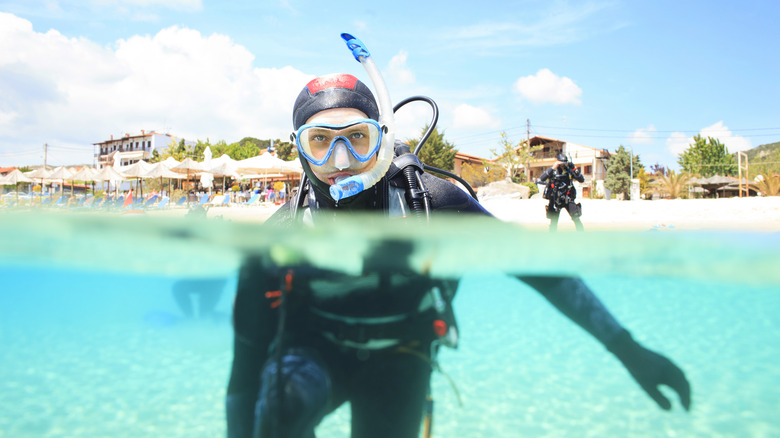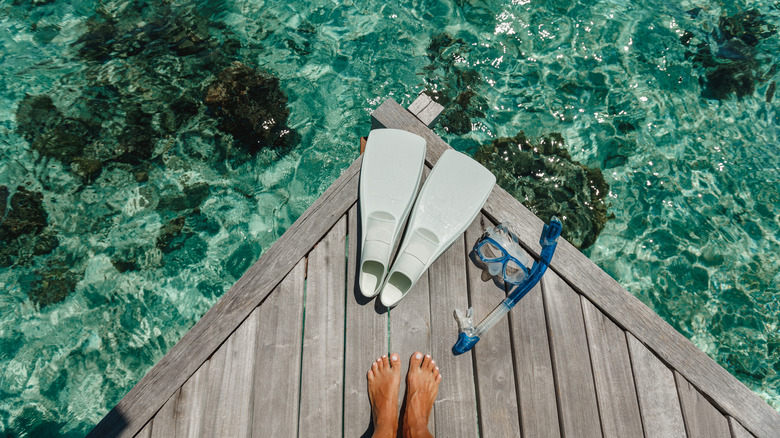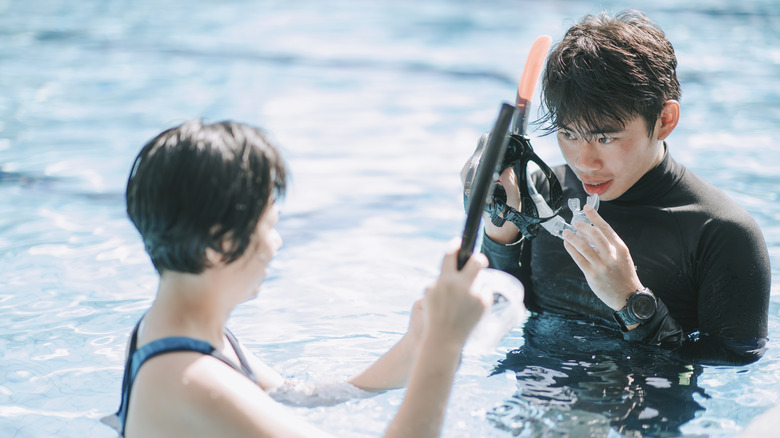Why Snorkeler's Still Face Drowning Risks Even In Very Shallow Waters
Snorkeling is widely regarded as a safe and fun way to observe marine life, requiring far less equipment and training than scuba diving. With just a snorkel, goggles, and perhaps even a pair of fins, you can float at the water's surface and marvel at the colorful corals and various sea creatures below. But while snorkeling is indeed accessible and can often be enjoyed safely even by non-swimmers, it is not without its dangers.
Among the risks, drowning is a significant hazard, even under conditions that might appear safe. For instance, snorkeling-related incidents are a top cause of accidental deaths in Hawaii, with many of the cases linked to a condition known as Snorkel Induced Rapid Onset Pulmonary Edema (SI-ROPE). In an exclusive interview with Islands, Ben Stokes, owner of dedicated snorkel travel company Snorkel Venture, explained that such threats persist even in the calm, shallow waters where most snorkeling takes place.
The method of snorkeling, rather than the time spent underwater, plays a crucial role in ensuring safety. Stokes pointed out that improper snorkeling techniques can induce a shallow water blackout, a dangerous condition that is brought about by prolonged breath-holding and resisting the natural urge to resurface for air. "This is where a lack of oxygen falls below the required level to maintain consciousness, in turn leading to drowning," he explained, noting that it can often arise without any prior warning. "There are also ear, sinus and lung risks to consider when leaving the surface as a snorkeler."
Remember that snorkeling always involves risks
Whether you're a seasoned ocean explorer or a first-time snorkeler, taking safety precautions is essential. The risk of drowning, or as mentioned, experiencing shallow water blackout, is present no matter the water conditions. It's vital to be vigilant about your snorkeling practices at all times. This includes not resisting the urge to come up for air between sets, not holding your breath for long periods of time, and snorkeling with a buddy. Don't hyperventilate before diving.
In his exclusive interview with Islands, Ben Stokes explained the common practices among professional swimmers and recreationists alike when snorkeling — freediving and skin diving. "As a 'Freediver' which is primarily about diving vertically down to achieve depth, this is generally considered a sport rather than a recreation," he shared. "The other practice is 'Skin Diving', this is a recreational activity where snorkelers leave the surface to explore an area of reef or marine environment usually to depths not much deeper than 20 meters/65ft."
The two snorkeling methods have stark differences, but while one appears to be "safer" than the other, Stokes emphasized that both carry inherent risks. In fact, he strongly advised against engaging in either practice until "you have understood those risks and undertaken some formal training."
For safe snorkeling, consider taking proper training
Ben Stokes suggests taking formal training for anyone serious about taking up snorkeling as a hobby. It is "the best, safest, and most fun way of getting into Freediving or Skin diving," he exclusively told Islands. Training with the help of a professional can equip you with essential skills, including proper snorkeling methods, common snorkeling mistakes to avoid, and practical tips for maintaining your equipment, such as getting rid of fog in your snorkeling mask.
"Most dive centres around the world offer training and certification alongside their Scuba courses," Stokes told Islands, noting that resources like the Professional Association of Diving Instructors (PADI) website offer a wealth of information about learning skin diving and freediving. Additionally, organizations like Scuba Schools International (SSI) and the International Association for the Development of Apnea (AIDA) provide specialized courses in freediving for those looking to advance their skills.
Ultimately, the choice to pursue formal training is yours, but Stokes strongly recommends it as the best way to learn snorkeling safely. Whichever you choose, Stokes advised, "Remember to have fun, be safe, and always dive with a buddy!"


